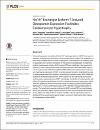In vitro evaluation of Neosetophomone B inducing apoptosis in cutaneous T cell lymphoma by targeting the FOXM1 signaling pathway
عرض / فتح
التاريخ
2023المؤلف
Kuttikrishnan, ShilpaMasoodi, Tariq
Ahmad, Fareed
Sher, Gulab
Prabhu, Kirti S.
Mateo, Jericha M.
Buddenkotte, Joerg
El-Elimat, Tamam
Oberlies, Nicholas H.
Pearce, Cedric J.
Bhat, Ajaz A.
Alali, Feras Q.
Steinhoff, Martin
Uddin, Shahab
...show more authors ...show less authors
البيانات الوصفية
عرض كامل للتسجيلةالملخص
Background: Cutaneous T cell lymphoma (CTCL) is a T cell-derived non-Hodgkin lymphoma primarily affecting the skin, with treatment posing a significant challenge and low survival rates. Objective: In this study, we investigated the anti-cancer potential of Neosetophomone B (NSP-B), a fungal-derived secondary metabolite, on CTCL cell lines H9 and HH. Methods: Cell viability was measured using Cell counting Kit-8 (CCK8) assays. Apoptosis was measured by annexin V/PI dual staining. Immunoblotting was performed to examine the expression of proteins. Applied Biosystems' high-resolution Human Transcriptome Array 2.0 was used to examine gene expression. Results: NSP-B induced apoptosis in CTCL cells by activating mitochondrial signaling pathways and caspases. We observed downregulated expression of BUB1B, Aurora Kinases A and B, cyclin-dependent kinases (CDKs) 4 and 6, and polo-like kinase 1 (PLK1) in NSP-B treated cells, which was further corroborated by Western blot analysis. Notably, higher expression levels of these genes showed reduced overall and progression-free survival in the CTCL patient cohort. FOXM1 and BUB1B expression exhibited a dose-dependent reduction in NSP-B-treated CTCL cells.FOXM1 silencing decreased cell viability and increased apoptosis via BUB1B downregulation. Moreover, NSP-B suppressed FOXM1-regulated genes, such as Aurora Kinases A and B, CDKs 4 and 6, and PLK1. The combined treatment of Bortezomib and NSP-B showed greater efficacy in reducing CTCL cell viability and promoting apoptosis compared to either treatment alone. Conclusion: Our findings suggest that targeting the FOXM1 pathway may provide a promising therapeutic strategy for CTCL management, with NSP-B offering significant potential as a novel treatment option.
المجموعات
- الأبحاث [121 items ]
- أبحاث الطب [1645 items ]
- أبحاث الصيدلة [1358 items ]
وثائق ذات صلة
عرض الوثائق المتصلة بواسطة: العنوان، المؤلف، المنشئ والموضوع.
-
The Role of Epidermal Growth Factor Receptor Family of Receptor Tyrosine Kinases in Mediating Diabetes-Induced Cardiovascular Complications
Shraim B.A.; Moursi M.O.; Benter I.F.; Habib A.M.; Akhtar S. ( Frontiers Media S.A. , 2021 , Article)Diabetes mellitus is a major debilitating disease whose global incidence is progressively increasing with currently over 463 million adult sufferers and this figure will likely reach over 700 million by the year 2045. It ... -
Universal Genetic Testing for Newly Diagnosed Invasive Breast Cancer
Rezoug, Zoulikha; Totten, Stephanie P.; Szlachtycz, David; Atayan, Adrienne; Mohler, Kristen; Albert, Sophie; Feng, Leila; Lemieux Anglin, Brianna; Shen, Zhen; Jimenez, Daniel; Hamel, Nancy; Meti, Nicholas; Esfahani, Khashayar; Boileau, Jean-François; Prakash, Ipshita; Basik, Mark; Meterissian, Sarkis; Tremblay, Francine; Fleiszer, David; Anderson, Dawn; Chong, George; Wong, Stephanie M.; Foulkes, William D.... more authors ... less authors ( American Medical Association , 2024 , Article)IMPORTANCE Between 5% and 10% of breast cancer cases are associated with an inherited germline pathogenic or likely pathogenic variant (GPV) in a breast cancer susceptibility gene (BCSG), which could alter local and systemic ... -
Na+/H+ exchanger isoform 1-induced osteopontin expression facilitates cardiomyocyte hypertrophy
Mohamed, Iman A.; Gadeau, Alain-Pierre; Fliegel, Larry; Lopaschuk, Gary; Mlih, Mohamed; Abdulrahman, Nabeel; Fillmore, Natasha; Mraiche, Fatima... more authors ... less authors ( Public Library of Science , 2015 , Article)Enhanced expression and activity of the Na+/H+ exchanger isoform 1 (NHE1) has been implicated in cardiomyocyte hypertrophy in various experimental models. The upregulation of NHE1 was correlated with an increase in osteopontin ...




